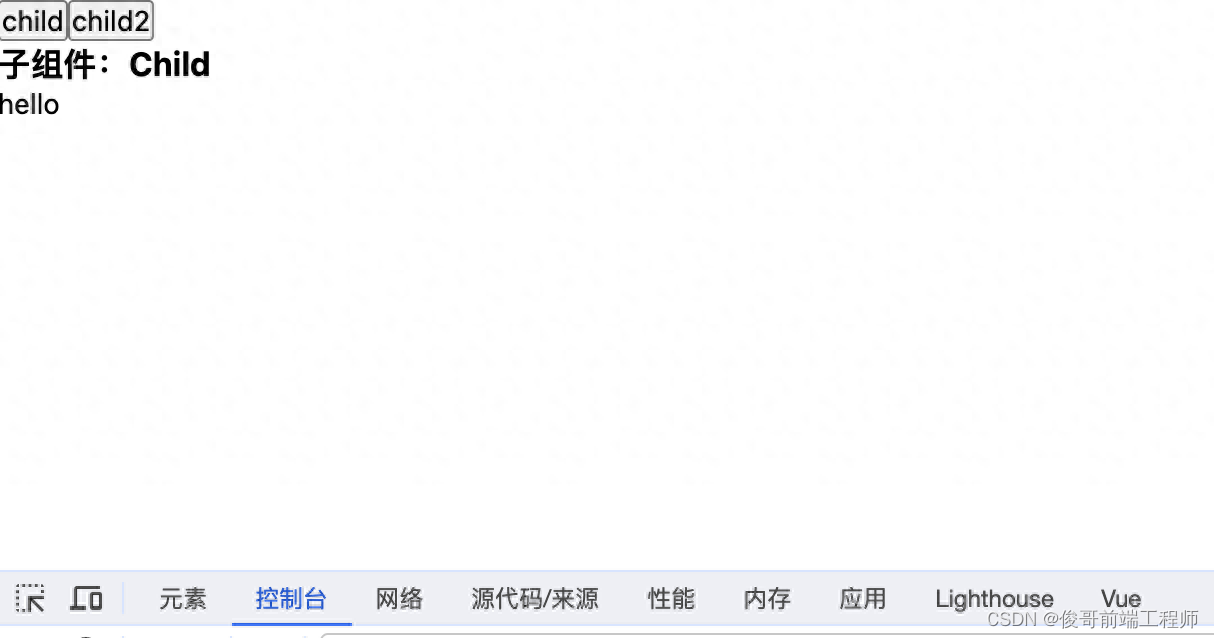is属性来指定要渲染的组件(填写组件名)
多个子组件通过component标签挂载在同一个父组件中, 可以修改is属性进行动态切换组件。
可以搭配<keep-alive></keep-alive>使用。
父组件代码:
<template><div style="font-size: 14px;"><buttonv-for="(item, index) in componentsList":key="index"@click="currentComponent = item.comName">{{ item.name }}</button><!-- 同样可以传递props参数 等 --><component :is="currentComponent" :text="text"></component></div>
</template><script lang="ts">
import child from './child.vue'
import child2 from './child2.vue'
import { defineComponent, reactive, ref, shallowRef } from 'vue'
// vue3.0 版本语法
export default defineComponent({name: '父组件',components:{child,child2},setup () {// reactive 会使数据变成响应式,此处为了节省性能开销,可以使用 shallowRef 或者 markRaw 跳过 proxy 代理const currentComponent = shallowRef(child)const text = ref('hello')const componentsList = reactive([{name: 'child',comName: shallowRef(child)},{name: 'child2',comName: shallowRef(child2)},])return {currentComponent,text,componentsList}}
})
</script>Child子组件代码:
<template><h3>子组件:Child</h3>{{ text }}
</template><script lang="ts">
import { defineComponent } from 'vue'
// vue3.0 版本语法
export default defineComponent({name: 'Child',props: {text: {type: String,default: '',},},setup () {return {//}}
})
</script>Child2子组件代码:
<template><h3>子组件:Child2</h3>{{ text }}
</template><script lang="ts">
import { defineComponent } from 'vue';
// vue3.0 版本语法
export default defineComponent({name: "Child2",props: {text: {type: String,default: '',},},setup() {return {//};},
});
</script>
初始页面显示结果:

点击Child2按钮切换组件》页面显示结果:
欢迎关注我的原创文章:小伙伴们!我是一名热衷于前端开发的作者,致力于分享我的知识和经验,帮助其他学习前端的小伙伴们。在我的文章中,你将会找到大量关于前端开发的精彩内容。
学习前端技术是现代互联网时代中非常重要的一项技能。无论你是想成为一名专业的前端工程师,还是仅仅对前端开发感兴趣,我的文章将能为你提供宝贵的指导和知识。
在我的文章中,你将会学到如何使用HTML、CSS和JavaScript创建精美的网页。我将深入讲解每个语言的基础知识,并提供一些实用技巧和最佳实践。无论你是初学者还是有一定经验的开发者,我的文章都能够满足你的学习需求。
此外,我还会分享一些关于前端开发的最新动态和行业趋势。互联网技术在不断发展,新的框架和工具层出不穷。通过我的文章,你将会了解到最新的前端技术趋势,并了解如何应对这些变化。
我深知学习前端不易,因此我将尽力以简洁明了的方式解释复杂的概念,并提供一些易于理解的实例和案例。我希望我的文章能够帮助你更快地理解前端开发,并提升你的技能。
如果你想了解更多关于前端开发的内容,不妨关注我的原创文章。我会不定期更新,为你带来最新的前端技术和知识。感谢你的关注和支持,我们一起探讨交流技术共同进步,期待与你一同探索前端开发的奇妙世界!


【深搜+打表】)
Demo及编写注意事项)

)


)







分析?)


